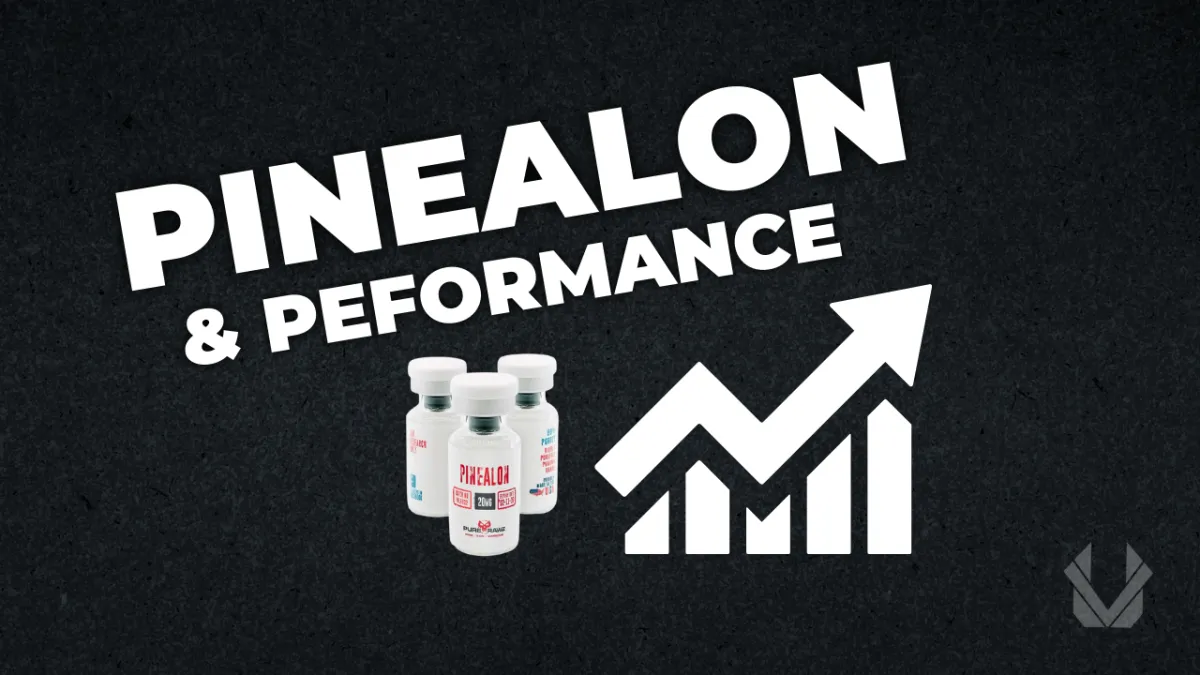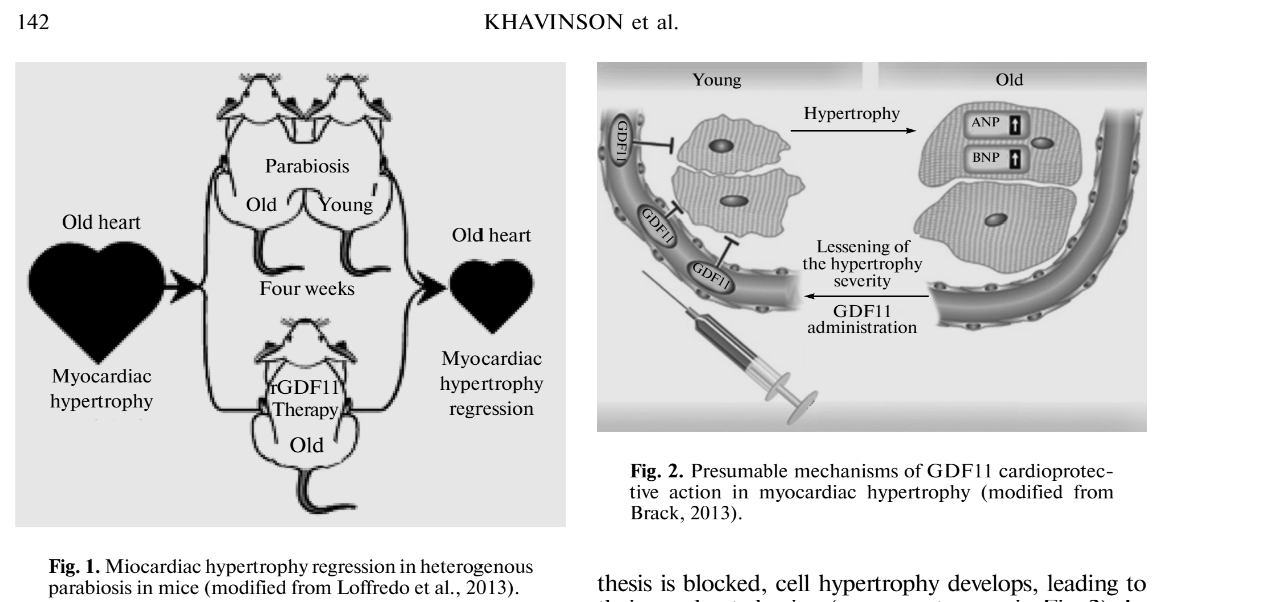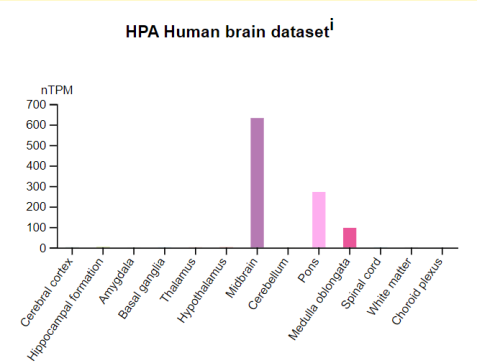THE UNYIELDING VIGOR BLOG
Our goal is to give you the most scientifically accurate and POWERFUL biological enhancement resources in the world
We're here to set new standards for truth, accuracy and effectiveness in the health industry. You'll find more value and scientific proof in our free articles than in most content you pay for.

Pinealon Brain Bioregulator
Pinealon Brain Bioregulator
Brenden Henry here, the worlds leading expert in peptide science. This article is the most comprehensive write up of pinealon that exists online, proven with over 100 scientific citations!
But if you just want a bit less of a scientific overview on pinealon, you can just listen to the below video where I cover all of its main benefits along with some personal stories.
On my quest for cognitive enhancement and overall well-being, I stumbled upon a peptide that would forever change my life, Pinealon. This one stood out as special to me because it was one of the few Khavinson peptides which had a plethora of research backing it, if you know where to look that is.
In a world that is getting increasingly challenging to navigate, we need to be as cognitively enhanced as possible, and I feel it's my duty to share my knowledge and experiences to help you evolve every day and conquer your limits, which is why I'm sharing this blog post with you today.
The first time I ordered Pinealon, it almost slipped through my fingers. Misdelivered from my address, I was initially crestfallen, but my curiosity and determination drove me to extraordinary lengths. I began a door-to-door search, knocking on neighbors' doors in the hope of reclaiming it. After leaving messages and exhausting all avenues, one neighbor came through, returning the misdelivered package.
That night, with Pinealon in hand, I decided to experiment with it as a nasal spray. The effects were nothing short of remarkable. As rain pattered against the window and darkness enveloped the world outside, I felt a subtle shift in my mood, a gentle wave of bliss washing over me. Colors seemed more vivid, sounds more vibrant, and my mind, astonishingly clear-headed.
Driven by newfound energy and clarity, I decided on a workout, eager to put Pinealon's reputed physical enhancing properties to the test. The workout felt great as my muscles didn't seem to tire as fast and as you'll discover in today's blog post, Pinealon not only enhances cognitive function but also physical endurance and performance.
Introduction:
Pinealon is a Cytogen also known as 'EDR,' it is composed of the amino acid sequence Glu-Asp-Arg and has a molecular weight of 418.41. Contrary to its name and certain influencer claims, Pinealon's origin isn't in the pineal gland. This cytogen finds its roots in cortexin ¹, indicating that it is naturally present in bovine or porcine cortex, specifically those less than 1 year old. Pinealon is the most powerful Khavinson peptide for enhancing cognition and improving physical performance in healthy individuals based on currently available data. It also demonstrates potent Gero protective and neuroregenerative effects, capable of completely reversing damage caused by Alzheimer's and Huntington's diseases in vitro ²³ ²⁴. Similar to all of Khavinson's peptides, its mechanisms of action within the body involve ligand binding to various DNA promoter regions, influencing the expression of various genes.
Pinealon Mechanisms of action:
With Pinealon's remarkable capacity to directly enhance gene expression in mind, let's delve into some of the genes it regulates, offering us a clearer understanding of how it exerts its effects.
GDF11
⦁ Pinealon possesses a binding site within GDF11 and has been observed to provide similar benefits to GDF11, including an increase in its expression ⁵³.
While the full study "GDF11 protein as a geroprotector" is available through paid access only, having read the full study, Khavinson discusses how GDF11 was responsible for some cognitive improvement, age reversal, and health improvement effects, particularly in blood transfusions from young to older individuals. Of particular interest may be its ability to reverse cardiac hypertrophy, as seen in a screenshot from the study below:

As mentioned, GDF11 is considered a rejuvenation factor in old age ⁵⁴. It retards the aging process in male mice ⁵⁵ and reduces the depression phenotype in old mice by promoting neural autophagy ⁵⁶. Additionally, it plays a crucial role in stem cell production and DNA repair. However, it's worth noting that GDF11 levels tend to decline to near-zero at an average age of 73.71 years old ⁶⁹. GDF11 has been shown to increase vasculature in the hippocampus and cortex of old mice when administered systemically. Still, it does not cross the blood-brain barrier (BBB) in appreciable quantities ⁷¹. It shows benefits in spinal cord injury ⁷³. Higher GDF11 is associated with reduced incidence of cardiovascular events and death ⁷², and it's known for regenerating myocardial tissue after ischemic injury ⁷⁵. GDF11 is also a positive regulator of muscle growth ⁶⁰ and reverses age-related dysfunction in muscle ⁷⁴. It increases wound healing in diabetic mice ⁷⁶, shows anti-aging benefits to the skin ⁷⁷, and shows promise in AD ⁷⁸.
One important aspect I'd like to address concerning GDF11 is its impact on liver autophagy. It tends to decrease autophagy in the liver due to increased mTOR1C activation ⁹⁹. However, it's worth noting that rapamycin-induced autophagy can counteract this effect. Additionally, Pinealon activates alternative pathways, such as irisin and PPARs, which actually promote hepatic autophagy. Therefore, it shouldn't raise concerns.
When examining these "bioregulator" peptides like Pinealon, it's essential to consider the broader context rather than focusing solely on a specific gene in isolation. Given its natural origin in young and healthy animals, it's unlikely to be detrimental to health. This is one of the reasons why Khavinson's peptides are known for their absence of side effects.
FKBP1B
⦁ Pinealon binds to the histone H1.3 protein and increases the expression of the FKBP1b gene ⁴⁶. FKBP1b has been shown to reverse age-related intracellular Ca2+ dysregulation, cognitive and memory impairments in aging rats, and restore the expression of 872 out of 876 genes in the direction opposite of aging in the hippocampus of mice, which are associated with structure categories including cytoskeleton, membrane channels, and extracellular region ⁴⁹. Early AD also shows downregulated FKBP1B ⁴⁷ ⁴⁸.
PPAR's
⦁ Pinealon significantly upregulates PPARA/G genes in humans and improves the performance of wrestlers ¹¹ ⁵⁰. The PPARA/G genes have strong associations with athletic performance ⁵⁸. PPARG upregulation is a potential target to benefit spinal cord injury ⁸². PPAR gene polymorphisms associated with the "g" allele result in decreased function and have a high correlation to reduced hand grip strength ⁸⁹, increased risk of breast cancer ⁹⁰, and AD ⁵¹. PPARA also has an important role in regulating autophagy and clearing AB plaques by increasing the microglia and astrocytes around the AB plaques and enhancing the formation of autophagosomes ⁶¹.
HSPA1A
⦁ Pinealon upregulates HSPA1A by about 3x in humans, though the dosage used was not specified ¹¹ ⁵⁰. It codes for heat shock protein 70 and is associated with the learning process in mice put through the Morris water maze ⁸⁸. It improves insulin sensitivity and decreases lipids, including within the brain ⁵². It improves wound healing in vivo ⁸⁵, promotes proper AR function ¹⁰¹, prevents muscular dystrophy, and enhances muscle hypertrophy ¹⁰², as well as spermatogenesis ¹⁰³. It prevents aggregation of misfolded proteins such as what occurs in AD, Huntington's disease, and PD ⁸³, possibly partially through decreased cdk5 ⁹⁶ which also improves resistance to oxidative stress and an increase in SIRT1 ⁹⁸. Lower levels of heat shock protein 70 are also associated with ADHD in children, hinting that its upregulation may play a role in benefiting ADHD ⁹⁷.
FNDC5/Irisin
⦁ Pinealon increases FNDC5 gene expression, by binding to the gene in 5 regions, which codes for Irisin ²⁶. Irisin is a positive regulator of muscle growth ⁵⁹, restores nucleus pulposus cells in mice and stops disc degeneration ⁷⁹, and protects against motor dysfunction in rats with spinal cord injury ⁸⁰. It has been shown to increase telomerase and therefore the Hayflick limit ²⁶, as well as SIRT1 ⁸⁶, a longevity and anti-cancer pathway that activates caspases in cancer cells specifically but not healthy cells ⁸⁷. Irisin stimulates mitochondrial biogenesis and mitophagy ⁹⁵, prevents mitochondrial damage in PD ⁸⁴, and provides potent antioxidant effects and reduces ferroptosis in hypoxia ²⁸.
Caspase 3
⦁ Pinealon is able to bind directly to CASP3 ³⁰ and reduce caspase 3 expression ³¹, which is a regulator of apoptosis under hypoxia ²⁹, and it was found to be the best peptide tested for hypoxia ³². Inhibition of caspase 3 results in the upregulation of mitochondrial complex 1 of the electron transport chain, leading to increased ATP ³³. In spinal cord injury, caspase 3 is upregulated and leads to cell death, suggesting that lowering it can assist in spinal cord injury ⁸¹. In AD, caspase 3 activation has been shown to occur in dendritic spines in the hippocampus, leading to activation of calcineurin and phosphorylation of glur1, causing spine degeneration and memory deficits. Caspase 3 inhibition rescues these deficits ³⁴. Caspase 3 inhibition is also associated with pinealon's purported ability to regenerate the skin ⁷⁰.
TPH1/Serotonin
⦁ Pinealon forms a hydrogen bond in the CCTGCC promoter region of the TPH1 gene, which increases its expression. This leads to increased serotonin synthesis within cultured cerebrocortical neurons of mice origin ². In humans, the TPH1 gene has been found to have low expression in the cortex but high expression in the midbrain, such as the raphe nuclei ³. Therefore, it is logical to assume that increased serotonin synthesis would primarily occur in the midbrain in humans.
However, its important to point out that TPH1 does not have much expression in the human brain compared to TPH1 as you can see in the comparison images below. Please note the "nTPM" difference between each. Therefore, the serotonin synthesis from pinealon can be considered negligible.
TPH1

TPH2

For an overview of serotonin synthesis ⁴.
Pinealon enhances cognition, mood, TBI recovery, protects from hypoxia, reverses neurodegeneration, and improves physical performance.
⦁ Improved intellectual markers in male wrestlers and older men ¹¹.
⦁ Improved spatial orientation and attention in aging rhesus monkeys while increasing the speed of learning by 1.5x ¹⁰.
⦁ Improved mice performance in the Morris water maze and was associated with increased Nr2a/Nr2b ratio. The enhanced memory was retained even after streptozotocin-induced diabetes ⁸.
Conferred neuroprotection to NMDA receptors by inhibiting the deleterious effects of high homocysteine, through preventing homocysteine's activation of ERK1/2 in NMDAR's ¹⁰⁰. It was noted more effective than carnosine for this purpose and at much lower concentrations.
⦁ Improved rats' performance in the water maze in comparison to cortexin ⁹.
⦁ Improved asthenic symptoms and psych emotional state in workers under stressful conditions ¹².
⦁ In TBI, Pinealon improved memory, lowered intensity and duration of headaches, increased emotional stability, and improved sense of well-being and being rested after a night's sleep, accounting for Pinealon's regenerative properties ⁵⁷.
-Pinealon is patented for its ability to regenerate neurons, improve spinal cord injury in rodents, and enhance motion coordination.¹⁰⁴ ¹⁰⁵
⦁ Protects rat offspring from prenatal hyperhomocysteinemia ⁶⁶, prenatal hypoxia ⁶⁷, and in vivo hypobaric hypoxia, doubling the time needed for rats to reach respiratory arrest ⁶⁸.
⦁ Pinealon is shown to completely reverse the damage to mushroom spines in hippocampal cultures treated with Aβ42 in the amyloid synaptotoxicity AD model ²³, completely restores the damage to dendritic spines in Medium Spiny Neurons in an in vitro model of Huntington's disease ²⁴, and improves locomotion and accuracy of movements in a flying insect model of Parkinson's disease ²⁵.
⦁ Increases athletes' performance, breath-holding time, and decreases markers of biological aging ¹¹.
Pinealon physical performance enhancement

Furthermore, in rats that were running on treadmill until exhaustion, it increased the time ran by up to 254%. However it should be noted that it was injected in this study at an unknown dosage.

Pinealon also increased heart rate power curves in athletes. The heart rate was 10-12 beats per minute lower while exerting the same power output.

Pinealon significantly heightens PPARA/G genes in humans which are associated with exercise performance. Additionally, Pinealon boosts FNDC5 gene expression, activating irisin—a myokine released by muscle cells during exercise. This, in turn, triggers increased glucose uptake into muscle cells during and after training, mediated by the upregulation of glucose transporter GLUT4 through AMPK activation. This synergy enhances exercise effects and improved performance.
Pinealon vs SSRIs:
Pinealon only enhances the synthesis of serotonin through TPH1, rather than inhibiting SERT. It may have a low incidence of sexual side effects because TPH1 is expressed in the hypothalamus ³, where it's shown to be a potential target to decrease neuroendocrine disruption ⁵. SSRIs decrease rats' performance in the Morris water maze test ⁶, which is used to evaluate spatial memory and learning. SSRIs are generally associated with memory impairments in humans, though not always ⁷. Pinealon has been shown to improve healthy mice and rats' performance in the water maze test ⁸ ⁹and improve some intellectual functions in wrestlers ¹¹.
Pinealon vs Cortexin:
Pinealon has been shown to stimulate proliferative activity of neurons more than cortexin, as indicated by increased ki-67 and vimentin. Pinealon has also shown to reduce apoptosis more than cortexin as indicated by reduced p53 expression.


As mentioned earlier, pinealon is also shown to improve cognition in healthy humans ¹¹. and improves mice performance in the water maze test more than cortexin ⁹.
ERK1/2 activation:
Serotonin signals through GPCRs to increase cAMP levels ¹³, which activates PKA, which phosphorylates CREB. CREB plays a role in LTP, which is believed to be a cellular basis for learning and memory ¹⁴. PKA can activate the ERK1/2 pathway directly ¹⁵, or it can be activated in some 5-HT receptors through GPCRs, β-arrestins, and small GTPases ¹⁵. ERK1/2 is not associated with an increase in inflammatory cytokines, unlike other MAPKs such as p38 and JNK ¹⁶. Irisin and ERK1/2, which pinealon also activates directly, can each reinforce the other ²⁷ ⁴¹.
Activation of ERK1/2 influences cellular redox balance by activating NRF2, which in turn activates heme oxygenase 1, glutathione, catalase, and superoxide dismutase, all of which are antioxidants ¹⁷. Pinealon has been shown in a study of cerebellar neurons to activate ERK1/2, possibly through the mechanisms explained above, though it could be multifaceted, and this activation is at least partially responsible for protecting those cells in a dose-dependent manner from hydrogen peroxide ¹⁸. However, pinealon's speculated ability to bind to three regions in the GPX1 gene, which code for glutathione, and regions in the SOD1 gene which code for superoxide dismutase, may also contribute to its demonstrated antioxidant effect ¹⁹(table 1).
Pinealon in AD:
The above study showing protection from H2O2 is relevant to AD, as oxidative stress is one of the theories implicated in AD ²⁰, and H2O2 is generated during the early stages of aggregation of amyloid plaques associated with AD ²¹. According to the A1 astrocyte theory, damage caused by amyloid plaques can trigger microglia to release pro-inflammatory cytokines, chemokines, and ROS, thereby leading to A1 type astrocytes, which ultimately cause neurons and oligodendrocytes to self-destruct. This phenomenon is also seen in Parkinson's disease and Huntington's disease ²².
The hippocampus is the main brain region where neurogenesis can still occur throughout adulthood. It has been found that reductions in hippocampal neurogenesis may contribute to cognitive impairments, tau hyperphosphorylation in neurons, and compromised hippocampal circuitry in Alzheimer's disease ³⁹ ⁴⁰. When Aβ42 peptide is added to a culture of neurons, inhibition of ERK1/2, PI3K/Akt, and consequently BDNF occurs, which leads to mitochondrial dysfunction, secretion of pro-inflammatory cytokines, and cell death ⁴⁵. GDF11 improves neurogenesis and vascularization ⁷¹ ⁷⁸, heatshock protein 70 prevents aggregation of misfolded proteins ⁸³, PPARA improves the correct functioning of microglia and astrocytes ⁶¹, non-amyloidogenic ERK1/2 ³⁵ ³⁶ stimulates neurogenesis in the hippocampus, and Irisin additionally activates STAT-3 and BDNF in the hippocampus ⁴¹ ⁴². STAT-3 activation has also been shown to reverse cognitive deficits in AD by increasing NMDAR expression and synaptogenesis, which is inhibited in AD by increased oligomeric amyloid beta peptide that causes internalization of the receptor and weakens synapses ⁴³ ⁴⁴. The ERK1/2 pathway also stimulates oligodendrocytes to myelinate axons, protecting neurons ³⁷. Myelination is reduced in Alzheimer's disease and ERK1/2 restores myelination ³⁸. It is through these mechanisms and all of the above targets, such as GDF11, FKBP1B, HSPA1A, and PPARA/G, that may contribute to the complete regeneration seen in Ab42 toxicity model.
Pinealon in Parkinson's:
As for how Pinealon improved symptoms in Parkinson's disease ²⁵ and increased DOPA and Dopamine ⁶⁵, there are two potential mechanisms outside of the earlier noted regenerative abilities. Pinealon was shown to have a binding site within the CALM1 gene ⁶⁴, which codes for calmodulin. The binding analysis did not state whether it increased or decreased its activity. Since calmodulin can bind to Gi proteins in the D2 receptor and increased its signaling through a cAMP mechanism, it is possible that Pinealon increased CALM1 and hence led to an increase in D2 signaling ⁶². This would explain the enhanced locomotion and accuracy of movements witnessed in flying insects. However, there is also the fact that PPARA regulates cholinergic-driven activity of midbrain dopamine through a mechanism involving α7 nicotinic receptors ⁶³. This would also make sense as α7 agonists showed benefits in PD.
Pinealon ROA and Dosing:
Capsules 2 1-2x daily- Purchase peptides on Vitastream- https://vita-stream.com/?ref=5eulikpi CHANGEAGE10 for 10% off.
Some of the TBI studies used injection at 0.01-0.1mg/kg body weight.
And for the most scientifically accurate masterclass on peptides ever created, decoded from over 300 scientific research papers, as well as personal email conversations with almost every single one of their authors, get
PEPTIDE MASTERY
https://peptides.unyieldingvigor.com/
unleash your Vigor and conquer Your Limits!
-Brenden Henry
Sources:
1. https://www.ncbi.nlm.nih.gov/pmc/articles/PMC7795577/
2. https://pubmed.ncbi.nlm.nih.gov/24909721/
3. https://www.proteinatlas.org/ENSG00000129167-TPH1/brain
4. https://royalsocietypublishing.org/doi/10.1098/rspb.2022.1565
5.
https://www.tandfonline.com/doi/abs/10.1080/10937404.2011.578563?journalC
ode=uteb20
6. https://psycnet.apa.org/record/2002-17820-007
7. https://www.ncbi.nlm.nih.gov/pmc/articles/PMC5002481/
8. https://link.springer.com/article/10.1134/S181971242003006X],
9. https://pubmed.ncbi.nlm.nih.gov/28976148/
10. http://bulletin.antropos.msu.ru/en/article.php?id=701
12. https://pubmed.ncbi.nlm.nih.gov/23734521/
13.
https://molecularbrain.biomedcentral.com/articles/10.1186/s13041-014-0049-y
14.
15. https://www.nature.com/articles/s41401-018-0204-6
16. https://www.ncbi.nlm.nih.gov/pmc/articles/PMC419926/
17. https://pubmed.ncbi.nlm.nih.gov/25132361/
18.
https://www.researchgate.net/publication/51698801_Pinealon_Increases_Cell_Vi
ability_by_Suppression_of_Free_Radical_Levels_and_Activating_Proliferative_Pro
cesses
19.
https://www.ncbi.nlm.nih.gov/pmc/articles/PMC7795577/#B84-molecules-26-00
159
20. https://pubmed.ncbi.nlm.nih.gov/18838179/
21. https://pubmed.ncbi.nlm.nih.gov/16141213/
22. https://www.nature.com/articles/nature21029
23. https://link.springer.com/article/10.1007/s10517-017-3847-2
24.
25. https://link.springer.com/article/10.1134/S2079086421060025
26. https://pubmed.ncbi.nlm.nih.gov/26742748/
27. https://pubmed.ncbi.nlm.nih.gov/25869623/
28. https://pubmed.ncbi.nlm.nih.gov/35032153/
29. https://www.nature.com/articles/s41598-022-11343-0
30. https://pubmed.ncbi.nlm.nih.gov/34071923/
31. https://pubmed.ncbi.nlm.nih.gov/25051764/
32. https://pubmed.ncbi.nlm.nih.gov/18546825/
33. https://pubmed.ncbi.nlm.nih.gov/26742748/
34. https://www.nature.com/articles/nn.2709/
35. https://openscholarship.wustl.edu/etd/1301/].
36. https://pubmed.ncbi.nlm.nih.gov/21873225/].
37. https://www.jneurosci.org/content/36/24/6471].
38. https://pubmed.ncbi.nlm.nih.gov/28453483/].
39.
https://molecularneurodegeneration.biomedcentral.com/articles/10.1186/1750-1
326-6-85
40.
https://molecularneurodegeneration.biomedcentral.com/articles/10.1186/s1302
4-017-0207-7
41. https://www.frontiersin.org/articles/10.3389/fncel.2022.953991/full
42. https://www.ncbi.nlm.nih.gov/pmc/articles/PMC4370428/
43. https://www.thno.org/v11p5511.htm
44. https://www.nature.com/articles/s41392-020-00290-9
45. https://pubmed.ncbi.nlm.nih.gov/15282285/
46.
https://www.researchgate.net/publication/333282004_Epigenetic_Mechanisms_
of_Peptide-Driven_Regulation_and_Neuroprotective_Protein_FKBP1b
47. https://pubmed.ncbi.nlm.nih.gov/24291098/
48. https://pubmed.ncbi.nlm.nih.gov/26224869/
49. https://pubmed.ncbi.nlm.nih.gov/29255009/
50. https://www.ncbi.nlm.nih.gov/pmc/articles/PMC4786580/
51. https://pubmed.ncbi.nlm.nih.gov/28346566/
52. https://www.ncbi.nlm.nih.gov/pmc/articles/PMC7051252/
53. https://link.springer.com/article/10.1134/S207908641602002X
54. https://www.ncbi.nlm.nih.gov/pmc/articles/PMC8109099/
55. https://pubmed.ncbi.nlm.nih.gov/30726519/
56. https://www.nature.com/articles/s43587-022-00352-3
57. https://patents.google.com/patent/US20120309688A1/en
58. https://www.ncbi.nlm.nih.gov/pmc/articles/PMC4786580/
59. https://www.nature.com/articles/s41467-017-01131-0
60. https://pubmed.ncbi.nlm.nih.gov/24797481/
61. www.ncbi.nlm.nih.gov/pmc/articles/PMC6984507/
62. https://www.sciencedirect.com/science/article/pii/S0021925820891492
63. https://www.ncbi.nlm.nih.gov/pmc/articles/PMC6618938/
65.
66. https://www.ncbi.nlm.nih.gov/pmc/articles/PMC3342713/
67. https://link.springer.com/article/10.1134/S1819712412030105
68.
https://www.deepdyve.com/lp/springer-journals/regulatory-peptides-protect-brai
n-neurons-from-hypoxia-in-vivo-4TtOl0EwRk?articleList=%2Fsearch%3Fquery%3D
Regulatory%2Bpeptides%2Bprotect%2Bbrain%2Bneurons%2Bfrom%2Bhypoxia%2
Bin%2Bvivo
69. https://www.ncbi.nlm.nih.gov/pmc/articles/PMC7915891/
70. https://pubmed.ncbi.nlm.nih.gov/22803085/
71. https://www.nature.com/articles/s41598-018-35716-6
72. https://pubmed.ncbi.nlm.nih.gov/26294790/
73. https://www.mdpi.com/1422-0067/24/1/421
74. https://pubmed.ncbi.nlm.nih.gov/24797481/
75. https://pubmed.ncbi.nlm.nih.gov/28004242/
76. https://www.nature.com/articles/s41401-022-01013-2
77. https://pubmed.ncbi.nlm.nih.gov/32283613/
78. https://ejnpn.springeropen.com/articles/10.1186/s41983-022-00487-5
79. https://pubmed.ncbi.nlm.nih.gov/35915608/
80.
https://www.researchgate.net/publication/346919436_Irisin_Protects_Against_M
otor_Dysfunction_of_Rats_with_Spinal_Cord_Injury_via_Adenosine_5'-Monophos
phate_AMP-Activated_Protein_Kinase-Nuclear_Factor_Kappa-B_Pathway
81. https://www.sciencedirect.com/science/article/abs/pii/S001448860097523X
82.
https://www.researchgate.net/publication/5452161_Potential_Therapeutic_Targ
ets_for_PPARg_after_Spinal_Cord_Injury
83. https://elifesciences.org/articles/47791
84. https://www.nature.com/articles/s41531-023-00453-9
85. https://pubmed.ncbi.nlm.nih.gov/16630101/
86.
https://www.cambridge.org/core/journals/expert-reviews-in-molecular-medicine/
article/irisin-enhances-longevity-by-boosting-sirt1-ampk-autophagy-and-telomera
se/6468B13563441D971B15E4677A5D7213
87. https://www.hindawi.com/journals/jobe/2019/6561726/
88. https://www.sciencedirect.com/science/article/abs/pii/S1074742702000084
89. https://josr-online.biomedcentral.com/articles/10.1186/s13018-021-02522-2
90. https://www.sciencedirect.com/science/article/abs/pii/S1526820916303676
91. https://pubmed.ncbi.nlm.nih.gov/20139991/
92. https://www.ncbi.nlm.nih.gov/pmc/articles/PMC5647161/
93. https://pubmed.ncbi.nlm.nih.gov/26374841/
94. https://eje.bioscientifica.com/view/journals/eje/170/4/501.xml
95.
https://skeletalmusclejournal.biomedcentral.com/articles/10.1186/s13395-020-0
0245-2
96. https://pubmed.ncbi.nlm.nih.gov/25829494/
97. https://www.ncbi.nlm.nih.gov/pmc/articles/PMC8895808/
98. https://pubmed.ncbi.nlm.nih.gov/27830023/
99. Growth differentiation factor 11 accelerates liver senescence through the inhibition of autophagy - PubMed (nih.gov)
101. https://www.nature.com/articles/s41467-019-11594-y
102.https://pubmed.ncbi.nlm.nih.gov/18644837/
103.Decreased expression of the heat shock protein hsp70-2 is associated with the pathogenesis of male infertility - PubMed (nih.gov)
GET OUR NEW, FREE TESTOSTERONE SUPPLEMENT GUIDE FOR 2024
Toxic Testosterone: The Hidden Health Risks of the 6 Most Common Testosterone Supplements
(Created and proven with the results of 107 scientific studies)

Unleash Your Vigor & Conquer Your Limits!
-Unyielding Vigor


